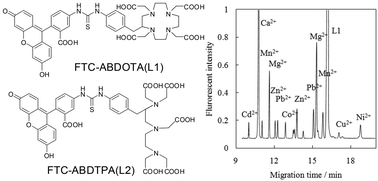Ultrasensitive CE for heavy metal ions using the variations in the chemical structures formed from new octadentate fluorescent probes and cationic polymers†
Abstract
Novel

* Corresponding authors
a
Graduate School of Science and Engineering, Saitama University, 255 Shimo-Okubo, Sakura-ku, Saitama, Japan
E-mail:
shingo@mail.saitama-u.ac.jp
Fax: +81 48 858 9534
Tel: +81 48 858 3559
b Department of Applied and Environmental Chemistry, Kitami Institute of Technology, 165 Koen-cho, Kitami, Hokkaido, Japan
c Graduate School of/College of Arts and Sciences, University of Tokyo, 3-8-1 Komaba, Meguro-ku, Tokyo, Japan
d Bioengineering Laboratory, RIKEN, 2-1 Hirosawa, Wako, Saitama, Japan
Novel

 Please wait while we load your content...
Something went wrong. Try again?
Please wait while we load your content...
Something went wrong. Try again?
S. Saito, Y. Nakano, A. Hikichi, R. Suzuki, K. Yoshimoto, M. Maeda, M. Aoyama and M. Shibukawa, Analyst, 2011, 136, 2697 DOI: 10.1039/C0AN00777C
To request permission to reproduce material from this article, please go to the Copyright Clearance Center request page.
If you are an author contributing to an RSC publication, you do not need to request permission provided correct acknowledgement is given.
If you are the author of this article, you do not need to request permission to reproduce figures and diagrams provided correct acknowledgement is given. If you want to reproduce the whole article in a third-party publication (excluding your thesis/dissertation for which permission is not required) please go to the Copyright Clearance Center request page.
Read more about how to correctly acknowledge RSC content.
 Fetching data from CrossRef.
Fetching data from CrossRef.
This may take some time to load.
Loading related content
